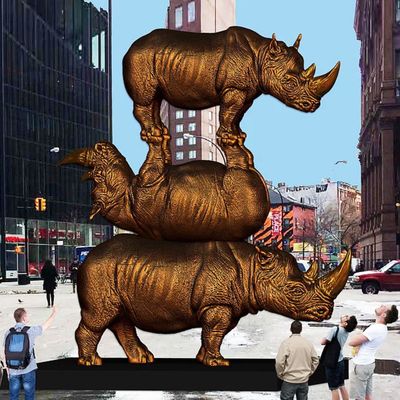
The Last Three, the seven-ton, 17-foot-high “tallest bronze rhino sculpture in the world,” made by the Australian “extraordinary public artists” Gillie and Marc — who, according to their website, “first met on a film shoot in Hong Kong; then 7 days later, ran away to Nepal and married on the foothills of Mt. Everest and whose unparalleled love is the cornerstone of what they are and what they create” — is now installed a few feet from Alamo, the spinning black cube by Bernard Rosenthal at Astor Place and Lafayette Street. It is an ugly, bathos-filled folly that proves my adage that 95 percent of all public sculpture is crap. Thank goodness this crap is only temporary.
This surreal-ish kitsch monstrosity is a stack of the last three northern white rhinos on Earth. The bottom one is standing with the next one resting on it, back to back — why? — facing up, and then supports the third one on its feet. It’s like a Vegas acrobatic act. The actual animals live protected around the clock in a small wildlife compound in northern Kenya. (Rhino horns, although they’re made of the same material as fingernails, are worth their weight in gold, which is why poachers destroyed the species.) On Gillie and Marc’s website (artists really need to use more than one name) you can see the saccharine sight of this ultrawhite couple — she resembles Nicole Kidman, he a young Christopher Reeve — petting, hugging, and kissing Sudan, 45, the male whose sperm count is too low to reproduce, and his daughter Najin, 27, and granddaughter Fatu, 11. Both of the females are infertile. This is the definition of the phrase “white mischief.”
Art-world aficionados may wince a little, gleaning the influence of artists like Jeff Koons, who has also made stacks of animals, or Takashi Murakami, who has always traded in amplified and exaggerated productions of serious subjects. Some will even spot the distant influence of Bruce Nauman’s extraordinary towers of taxidermied models. Gillie and Marc used $150,000 of their own money for the $200,000 sculpture (made in Thailand) and are raising the rest of the money on their Goodbye Rhinos website, where they offer supporters premiums like a one-foot-tall, limited-edition bronze of the sculpture of the last three rhinos for $2,500 (in Australian currency); or for $12,500 you can get a two-foot-high version of the artists’ From Here He Could See the World, which shows a rhino perched atop two stacks of colorful boulders. Whatever, The Last Three is mad-ugly, little more than a place to take selfies, a circus of extinction come to town. I wasn’t shocked to learn on their webpage that the couple is also responsible for one of my other least favorite works that I’ve seen in public, a gaggle of Paparazzi Dogs wearing press hats and taking pictures.
The artists may be ditzy and clueless when it comes to sculpture, but their hearts are in the right place. Indeed, they assure us that their “art explores relationships and love, and finds inspiration in our travels around the world and adventures that we’ve had or hope to have, together.” We all know how tragic and destructive it is that we’re wiping out species faster than ever before. And that this most mysterious and almost prehistoric-looking huge creature is now on the brink of extinction too. Had the punchy couple, perhaps, just placed these three standing rhinos, they would have had a presence that connected to the loss of these wonders. Instead they tried to be cute, smart, strange, mannered, and melodramatic. The sculpture is bad burlesque recklessness, a travesty that theatricalizes calamity.
We must accept that hating this work is not dissing the cause. Not liking the sculpture is to show the cause the deep respect it deserves and not selling it out to gaudy artsy spectacle. As an art critic, I also feel compelled to add that if you like the sculpture, I’m afraid it means that you have pretty bad taste.

